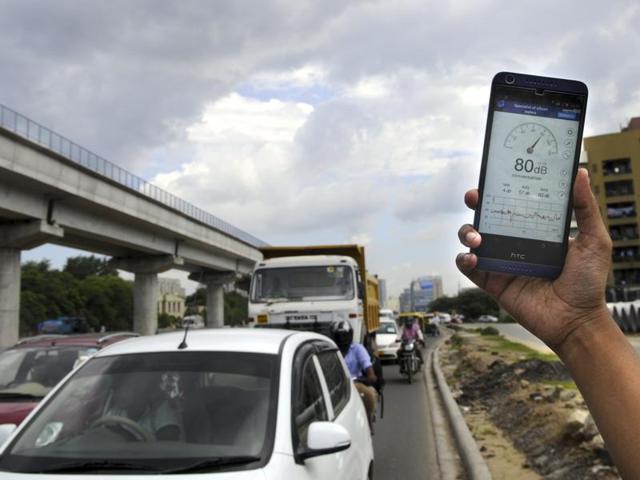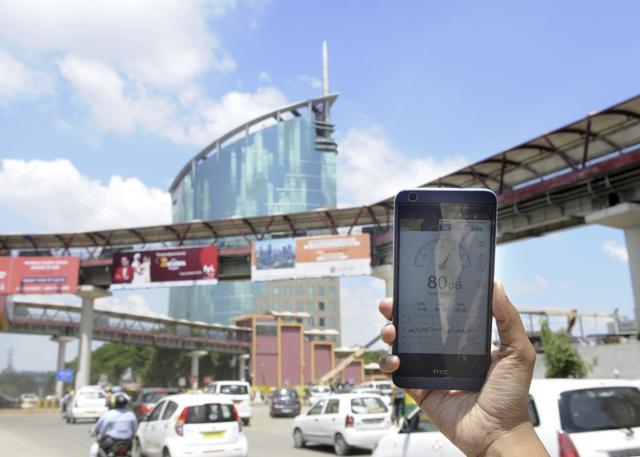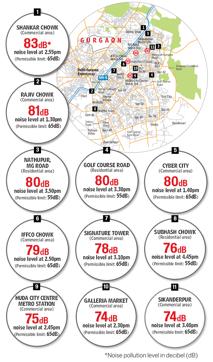Gurgaon noise levels blare past the safe zone
Around 70% of noise pollution in the city is caused by vehicles. The most problematic areas are those that are close to NH-8 and metro stations
The cyber city needs to tone it down. A recent survey by the Haryana state pollution control board (HSPCB) on MG Road and at Rajiv Chowk has revealed that the noise level over the last two years has cranked up by 30% in the areas adjoining the two spots.

In 2014, the two busiest spots recorded 60 and 65 decibels, respectively. It has now increased to 76 and 80 decibels, respectively. The acceptable range for human ears is around 40-50 decibels. With no sound barriers installed on NH-8 or on busy roads in the city, residents have to cover their ears for some relief.
A major contributor to the ruckus is vehicles. Around 45,000 driving licences and 80,000 vehicle registration certificates are issued annually in Gurgaon, amplifying the already high levels of noise on the roads.
“Around 70% of noise pollution in the city is caused by vehicles. The most problematic areas are those that are close to NH-8 and metro stations,” Bhupender Singh, regional pollution officer, HSPCB, said.
When enquired about the problem, National Highways Authority of India (NHAI) officials said pollution control board has to identify stretches before they can install noise barriers.
“We got an NOC (no objection certificate) from the pollution department in 2008 when NH-8 was constructed. If required, we will install barriers along the NH-8, but we need a noise mapping from HSPCB,” said Ashok Kumar, project director, NHAI.

HSPCB officials admit that a noise mapping, though essential for the city, was never done. “We do not have the power to conduct these surveys. Various agencies -- NHAI, Delhi Metro and Road Transport Authority -- are responsible for such studies,” a pollution control board official said.
Meanwhile, an HT team decided to test the noise levels in various parts of the city on Wednesday with the help of a mobile app.

The team visited 10 spots that are known to be overcrowded. It found that areas adjoining flyovers, highways and roads were heavy noise generators and recorded sound in the 80 decibel bracket, much higher than what is recommended by the central pollution control board (CPCB) for commercial and residential areas (see box).
According to the noise standards for ambient air and for automobiles, domestic appliances and construction equipment, which were notified in Environment (Protection) Rules, 1986, for a commercial area, the permissible limit is 65-55 decibels while that for a residential area is between 55-45 decibels.
In the overcrowded areas of Rajiv Chowk, Cyber Hub, Galleria Market, Iffco Chowk, Huda Metro station, Signature Tower, Golf Course Road, Sikanderpur, Nathupur and Sohna Road, on a normal day between 1:30 pm and 5pm, the sound level varies from 74 to 84 decibels.
Residents in these areas complain that the noise has become difficult to bear. “There are no sound barriers along the highway. It is difficult to sleep at night because of the traffic noise,” said Shilpa Kaushik, a resident of Heritage City, near MGF Mall.
Sangeeta Singh, a resident of Sector-30, said, “We stay close to NH-8. For the last one year, we are unable to get sound sleep. The city does not have enough green cover to absorb sound.”
This problem is perennial and only proper noise barriers can provide relief, experts said.
“Ideally, NHAI should put up sound barriers if there are residential units next to the road,” said the regional pollution officer.
“But, at present, a few noise insulators have been erected by the Delhi Metro near the area where the metro takes a steep turn to enter Gurgaon,” he said.
Various types of barriers can be used to mitigate noise created by traffic. “Noise barriers can cut at least 5 decibels,” the official said.
Thus, if noise insulators are put up in areas that have a heavy traffic volume, it can reduce noise pollution to a large extent. Until that happens, cover your ears or tune it out.
Stay updated with all the Breaking News and Latest News from Mumbai. Click here for comprehensive coverage of top Cities including Bengaluru, Delhi, Hyderabad, and more across India along with Stay informed on the latest happenings in World News.
Stay updated with all the Breaking News and Latest News from Mumbai. Click here for comprehensive coverage of top Cities including Bengaluru, Delhi, Hyderabad, and more across India along with Stay informed on the latest happenings in World News.





